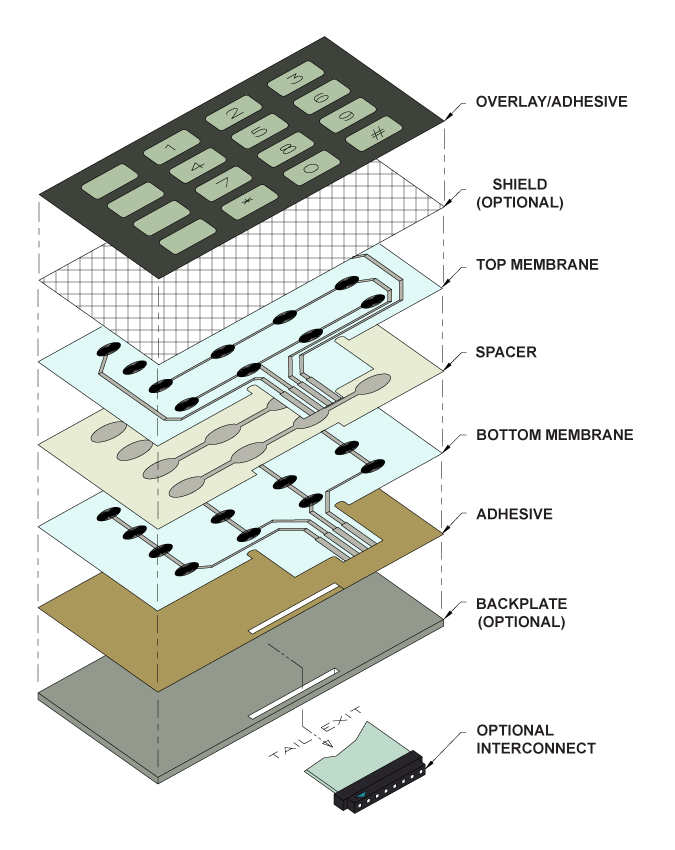Recognizing the Capability of Membrane Layer Switches Over for Individual User Interface Instruments
The performance of membrane layer switches over represents a considerable advancement in interface design, combining efficiency with aesthetic convenience. These buttons run through a multi-layered structure that translates customer communications into electric signals, enabling both small designs and resilience against ecological elements. As industries significantly focus on customer experience, recognizing the subtleties of membrane button technology ends up being necessary. What implications do these innovations hold for future applications, and exactly how might they redefine user communications across different gadgets?
What Are Membrane Buttons?
Membrane layer switches are innovative interface tools that assist in customer interaction with digital tools. These flexible elements contain numerous layers, including a visuals overlay, spacer, and a published circuit layer. The design enables for a seamless assimilation into different digital devices, enhancing both the aesthetic and useful elements of user interfaces.
Membrane layer buttons are generally utilized in a large range of applications, from house appliances to commercial equipment and clinical gadgets. Their construction usually features a thin account, making them an excellent option for compact styles. The responsive feedback given by these switches can be engineered to fulfill details individual preferences, guaranteeing effective interaction in between the user and the gadget.
Sturdiness is one more significant advantage of membrane layer switches, as they are resistant to dirt, moisture, and chemicals, which boosts their life-span popular atmospheres. Additionally, these buttons can be personalized in regards to shape, size, and graphic design, enabling branding and user-specific features. Generally, membrane layer switches over stand for a practical service for enhancing user experience in electronic tools, combining performance with visual charm in an effective fashion.
Just How Membrane Layer Switches Over Job
Operating on a straightforward principle, membrane layer changes use a layered construction to sign up user input successfully. Each button contains several layers, consisting of a published circuit layer, a spacer layer, and a leading visuals layer, which are created to interact perfectly. When a user presses the leading layer, it presses the spacer layer, bringing the conductive aspects of the circuit layer right into call with each other.
This call creates a closed circuit, signaling the gadget to perform a certain feature. The layout permits for various arrangements, including tactile comments, which can improve the individual experience by supplying a physical feeling upon activation. The materials made use of in membrane buttons frequently consist of flexible substrates, such as polyester or polycarbonate, which make sure toughness and resilience versus damage.

Trick Advantages of Membrane Layer Switches

One more considerable benefit is their density. Membrane layer switches are thin and lightweight, which allows producers to conserve area in their tools without compromising capability. This feature is particularly beneficial in applications where weight and volume are important factors to consider.
In addition, membrane layer switches are immune to dirt, wetness, and chemicals, boosting their sturdiness. This strength expands their lifespan and decreases the requirement for frequent substitutes, resulting in expense financial savings over time.
Moreover, the tactile feedback offered by membrane buttons can be optimized to improve individual communication. They can consist of functions such as raised switches or distinct clicks, enhancing usability and customer experience.
Applications Across Industries
Customer interface read what he said devices making use of membrane layer buttons are prevalent in a broad variety of industries, showcasing their versatility and performance. Membrane Switch. In the medical market, membrane layer switches are essential to gadgets such as diagnostic devices and patient tracking systems, where their sturdiness and simplicity of cleaning are important for maintaining health standards. In a similar way, in the vehicle sector, these switches are employed in dashboard controls and infotainment systems, giving a smooth and modern interface for users.
Additionally, the consumer electronics market gain from membrane layer buttons in devices and portable devices, where small design and user-friendly interfaces improve customer experience. Industrial applications also take advantage of membrane switches over for control board in equipment and automation systems, emphasizing their toughness and resistance to harsh environments.
In the aerospace and defense markets, membrane layer buttons are utilized in cabin controls and devices, where dependability and performance under great site severe problems are critical. Furthermore, the pc gaming sector progressively includes membrane layer switches in controllers and game machines, contributing to an appealing user experience. Generally, the adaptability of membrane changes allows their extensive use across many sectors, underscoring their significance in modern customer interface layout.
Future Trends in Membrane Switch Over Technology

In addition, using sophisticated materials, such as polycarbonate and polyester films, is anticipated to climb, providing boosted toughness and resistance to ecological stress factors. These products add to the general long life of membrane buttons, making them appropriate for harsher industrial applications.
Moreover, the consolidation of clever innovation, consisting of IoT connectivity, will certainly allow membrane layer switches to communicate with various other tools and systems, assisting in a much more interactive individual experience. This fad aligns with the growing demand for smart tools throughout various sectors, from healthcare to consumer electronics.
Finally, customization options are anticipated to broaden, allowing suppliers to produce bespoke solutions tailored to certain customer needs and preferences. These developments will certainly place membrane layer buttons as vital elements in the advancement of user interface other innovation.
Conclusion
In final thought, membrane layer switches over represent a pivotal innovation in interface innovation, offering a dependable and versatile remedy for diverse digital applications. Their split building and construction promotes small design, while features such as tactile responses enhance customer communication. The toughness against ecological aspects further strengthens their energy throughout several industries. As innovations in product science and touch picking up innovations proceed, the performance and applicability of membrane layer buttons are expected to broaden, reinforcing their significance in modern digital devices.
Comments on “The Role of a Membrane Switch in Modern Touch Interfaces and Controls”